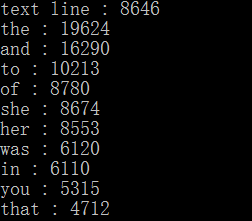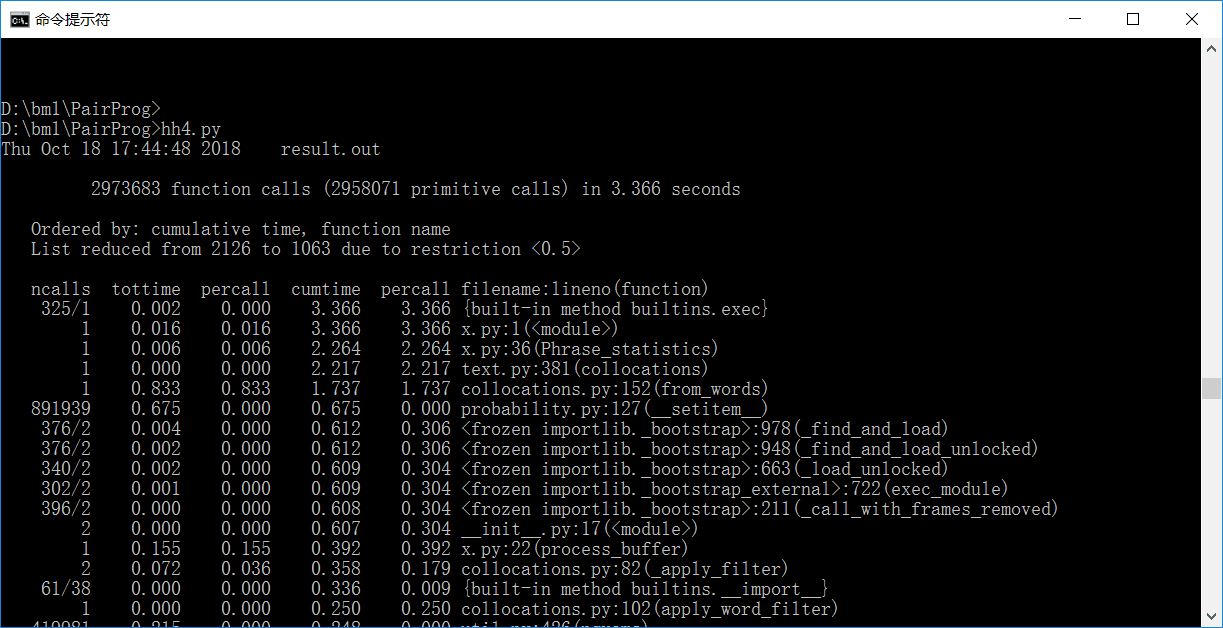一、基本信息
1.1 本次作业地址:https://edu.cnblogs.com/campus/ntu/Embedded_Application/homework/2088
1.2 项目的Git地址:https://gitee.com/ntucs/PairProg
二、项目分析
2.1 程序运行模块(方法、函数)介绍
①任务一:读取文件、统计行数写入result.txt方法
import re import jieba from string import punctuation def process_file(dst): # 读文件到缓冲区 try: # 打开文件 f=open(dst,'r') except IOError as s: print (s) return None try: # 读文件到缓冲区 x=f.read() except: print ("Read File Error!") return None bvffer=x return bvffer
②任务一:使用正则表达式统计词频,存放如字典模块
def line_count(dst): count=0 for index,line in enumerate(open(dst,'r')): count+=1 print("text line :",count) def process_buffer(bvffer): c=bvffer.lower() result=re.sub("[0-9]+[a-z]+"," ",c) re1=re.findall('[a-z]+\w+',result) d=open("stopwords.txt",'r').read() if re1: word_freq = {} # 下面添加处理缓冲区 bvffer代码,统计每个单词的频率,存放在字典word_freq for word in re1: if word not in d: if word not in word_freq: word_freq[word]=0 word_freq[word]+=1 return word_freq
③任务一:保存排名前十结果至result.txt模块
def output_result(word_freq): doc=open('result.txt','w') if word_freq: sorted_word_freq = sorted(word_freq.items(), key=lambda v: v[1], reverse=True) print(len(word_freq)) for item in sorted_word_freq[:10]: # 输出 Top 10 的单词 print(item[0],":",item[1]) print(item[0],":",item[1],file=doc) doc.close()
④任务一:主函数调用各个模块逻辑
if __name__ == "__main__": import argparse parser = argparse.ArgumentParser() parser.add_argument('dst') args = parser.parse_args() dst = args.dst line_count(dst) bvffer = process_file(dst) word_freq = process_buffer(bvffer) output_result(word_freq) word_frequency(bvffer)
⑤任务二:停词表模块
功能实现方法:使用 nltk(Natural Language Toolkit,自然语言处理工具包,在NLP领域中,最常使用的一个Python库。)下载英文停词表,存放到list_stopWords集合中,接着对将要处理的英文单词进行判断是否与list_stopWords中的词汇相等,如果相等则跳过,即停词功能。
代码模块如下:
d=open("stopwords.txt",'r').read() #停词 if re1: word_freq = {} # 下面添加处理缓冲区 bvffer代码,统计每个单词的频率,存放在字典word_freq for word in re1: if word not in d: if word not in word_freq: word_freq[word]=0 word_freq[word]+=1 return word_freq
任务二:列出高频短语模块
def Phrase_statistics(bvffer): #统计高频词组 text=nltk.text.Text(bvffer.split()) print(text.collocations())
2.2 程序算法时间、空间复杂度分析
def process_buffer(bvffer): c=bvffer.lower() result=re.sub("[0-9]+[a-z]+"," ",c) re1=re.findall('[a-z]+\w+',result) d=open("stopwords.txt",'r').read() if re1: word_freq = {} # 下面添加处理缓冲区 bvffer代码,统计每个单词的频率,存放在字典word_freq for word in re1: if word not in d: if word not in word_freq: word_freq[word]=0 word_freq[word]+=1 return word_freq
假设字典中有n个元素,执行一次就循环一次,共n次,所以时间复杂度为O(n),每次创建一个空间存放将要使用词,所以空间复杂度为O(1)
2.3 程序运行案例截图
result运行截图:

高频词组截图:

三、性能分析
3.1所花时间如下:

3.2性能表图:

四、其他
4.1 结队编程时间开销
每天1小时,大概一周左右完成全部功能。主要时间开销分两个部分——查阅技术文档、结队编程。大体分工为两位同学同时查阅技术文档,接着交流讨论。对各个技术方式实践结队编程最后选择最合适的方案。
4.2 结队编程照片

五、事后分析与总结
5.1简述结对编程时,针对某个问题的讨论决策过程
提取高频短语时,我们在解决方法方面出现了分歧
庄志强的想法是使用字符串组成想要提取的短语,马照彬的想法是使用nltk中的collection方法,分别试验后决定采用马照彬的方法
5.2互相评价
庄志强评价马照彬:编程能力强,能妥善解决编程中出现的问题
马照彬评价庄志强:在合作的过程中积极为项目做贡献,在查阅资料与学习方面不遗余力
5.3评价整个过程
结对编程是一个相互学习、相互磨合的渐进过程,团队合作对于编程而言也很重要
5.4建议
可以做大一点的项目,让同学们体会多人合作
5.5其他
在学习一门新的语言时要详细地了解这门语言的规则,并且有疑问的地方应多去查资料























 2513
2513

 被折叠的 条评论
为什么被折叠?
被折叠的 条评论
为什么被折叠?








